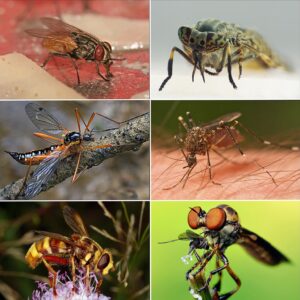Understanding Fly Control and Prevention for a Healthier Environment

Fly Biology
Flies are some of the most common pests, with thousands of species worldwide. Effective fly control and prevention are essential, as these insects can be more than just an annoyance. Many flies pose health risks by contaminating food and surfaces after feeding in unsanitary areas like excrement or decaying matter. Flies are often encountered in homes, supermarkets, restaurants, and other food-related spaces, making them a threat to human health. Additionally, they can also torment livestock, affecting both their comfort and survival.
Flies belong to the insect order Diptera, which also includes mosquitoes, gnats, and midges. A key characteristic of this order is their two wings (one pair), unlike most insects that have four wings. The reduced hind wings, called halteres, act as flight balancing organs. Flies have compound eyes, which are highly sensitive to motion and light, making them difficult to catch.
While many species of flies exist, pest control technicians commonly encounter only a few:
Common Fly Species
| Common Name | Scientific Name |
|---|---|
| House Fly | Musca domestica |
| Lesser House Fly | Fannia canicularis |
| Cluster Fly | Pollenia rudis |
| Stable Fly | Stomoxys calcitrans |
| Green & Blue Bottles | Calliphora spp. |
| Fruit Fly | Drosophila spp. |
| Gnats | Various species |
Fly Control

Effective fly control requires a comprehensive approach through Integrated Urban Pest Management (IUPM). This method addresses different control mechanisms to reduce fly populations while minimizing chemical use. The key components of an IUPM fly control program are:
- Cultural Control: Modifying the environment to make it less appealing to flies, such as relocating shrubs that attract flies away from entrances.
- Physical Control: Installing screens on doors and windows and ensuring proper sealing to prevent fly entry.
- Mechanical Control: Using electric units with ultraviolet light to attract and kill flies on contact.
- Biological Control: Eliminating fly breeding sites, such as removing dog feces or organic waste that serves as food for larvae.
- Legal Control: Collaborating with local health inspectors to ensure compliance with sanitation regulations.
- Chemical Control: Chemical treatments should be a last resort. When necessary, space sprays and residual sprays targeting adult flies can be used, although regular applications are typically required.
fly control and prevention is especially important in pest control for restaurants, where maintaining a hygienic environment is critical.
For further information on house fly management and control strategies, you can refer to the detailed guide provided by the University of California Agriculture and Natural Resources: Flies
FAQ
Q: What are common sources of flies in my home?
A: Flies are attracted to decaying organic materials such as food waste, garbage, pet waste, and dead animals. Keeping these areas clean is key to preventing fly infestations.
Q: How can I prevent flies from entering my home?
A: Ensure that doors and windows have proper screens, seal cracks, and promptly remove any food waste or organic debris inside and outside your home.
Q: Can flies transmit diseases?
A: Yes, flies are known carriers of bacteria and pathogens that can contaminate food and surfaces, making them potential transmitters of diseases like food poisoning.
Q: What is the most effective long-term method of controlling flies?
A: Proper sanitation, which includes eliminating all organic debris like food waste, garbage, and excrement, is the most effective long-term fly control method.
Q: Why are flies considered a health hazard?
A: Flies can spread diseases by coming into contact with human food or drink after breeding or feeding on excrement, dead animals, or other filth.
